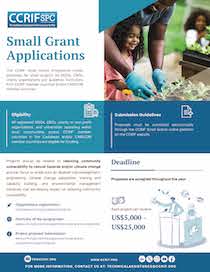Grand Cayman, August 19, 2013 – Over a two-day period, August 14 – 15, 25 meteorologists and disaster managers from across the region benefitted from training in the Caribbean Catastrophe Risk Insurance Facility’s (CCRIF’s) Real-Time Forecasting System (RTFS). The RTFS is an innovative forecasting tool which is designed to assist countries with pre-storm planning. This is the third year that this course has been offered, and is conducted in collaboration with the Caribbean Institute of Meteorology and Hydrology (CIMH), Kinetic Analysis Corporation (KAC) and the Caribbean Disaster Emergency Management Agency (CDEMA). To date, 150 persons have participated in the training course.
The RTFS is unique in that it provides information not available from other hurricane weather sources or forecasting systems. While all hurricane weather sites tell the user where the storm is heading and how strong it is likely to be, the RTFS tells the user what the storm is likely to do when it gets there - in terms of wind speed over land, storm surge and wave heights along the coast, total expected rainfall, number of people that may be affected by wind speed category, expected general damage levels, and expected down-time for ports and airports.
By providing advance knowledge of a hurricane’s expected site-specific impacts, the RTFS can assist meteorological officers and disaster management coordinators to support effective preparedness and response, decision making about potential evacuations and shelter management, planning for pre-positioning of equipment and supplies, activation of mutual assistance arrangements and management of assets as well as for contingency planning to secure critical infrastructure and operations.
This tool is available to CCRIF member countries and it is used by meteorological officers and disaster managers as well as officials from ministries of planning, tourism, agriculture and finance and also by persons from international development agencies working in disaster management. Currently, over 300 persons have been provided with access to the RTFS.
The usefulness of the RTFS was articulated last year by Mr. Fabrice Recault, GIS Coordinator for the World Food Programme-operated Logistics Cluster of the United Nations post-earthquake response mechanism in Haiti when he declared “I confirm that I will use your fabulous service during the 2012 hurricane season. It’s one of the most important sources of information during hurricane or tropical storm alerts here in Haiti.”
The 2013 Atlantic Hurricane Season is well underway with four named storms having already affected the region and with the peak of the season (mid-August to October) still to come. The US National Oceanic and Atmospheric Administration (NOAA) expects a 70 percent chance of an above-normal season with a total of 13 to 19 named storms, including six to nine hurricanes, of which three to five could be major (Category 3 to 5).
About CCRIF: CCRIF is a not-for-profit risk pooling facility, owned, operated and registered in the Caribbean for Caribbean governments. It is designed to limit the financial impact of catastrophic hurricanes and earthquakes to Caribbean governments by quickly providing short-term liquidity when a policy is triggered. It is the world’s first regional fund utilising parametric insurance, giving Caribbean governments the unique opportunity to purchase earthquake and hurricane catastrophe coverage with lowest-possible pricing. CCRIF represents a paradigm shift in the way governments treat risk, with Caribbean governments leading the way in pre-disaster planning. CCRIF was developed through funding from the Japanese Government, and was capitalised through contributions to a multi-donor Trust Fund by the Government of Canada, the European Union, the World Bank, the governments of the UK and France, the Caribbean Development Bank and the governments of Ireland and Bermuda, as well as through membership fees paid by participating governments.
Since the inception of CCRIF in 2007, the Facility has made eight payouts totalling US$32,179,470 to seven member governments. All payouts were transferred to the respective governments within two weeks after each event
English





